-
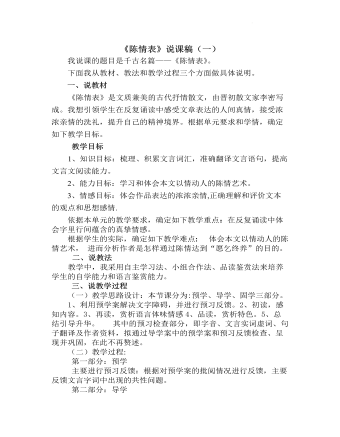
《陈情表》说课稿(一) 2021-2022学年统编版高中语文选择性必修下册
4、学习任务三:品读,赏析特色,深入探究。(解决“为什么这么陈情“的问题)文学史上,以获得“高难度”的险助而又收“高效率”奇功的,首推李密的《陈情表》。“抗君命”、“逆圣旨”,李密是为“辞不赴命”而上书的。让学生再读课文,结合导学案中的背景介绍,思考作者为什么这样陈情。 【方法导引】再读文本,深入思考作者除了从亲情入手打动晋武帝,还从哪些方面陈情以达到自己想要的效果?要求:独立思考,小组合作,梳理归纳,到黑板上展示。教师补充归纳:本文出于情,归于理,先动之以情,再晓之以理。李密是亡国旧臣,惹恼晋武帝,会被株连九族。先以祖孙相依为命的亲情凄切婉转的表明心意,唤起晋武帝的怜悯之心,再以“报国恩”“徇私情”的两难和朝廷以“孝”治国以及自己为官追求等,打消皇帝疑虑,最终提出先尽孝后尽忠的解决方案,以情动人,构思缜密。整篇《陈情表》密布着感情的浓云,陈情于事,寓理于情,凄恻动人。
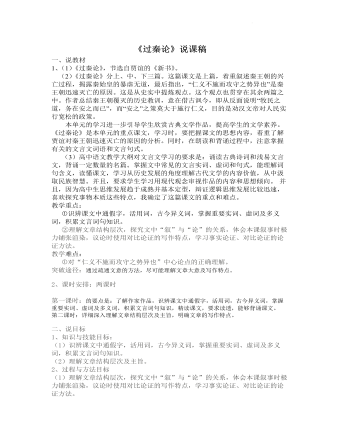
《过秦论》说课稿 2021—2022学年统编版高中语文选择性必修中册
三、教学方法为了突出重点,突破难点,完成教学目标,选择行之有效的教学方法是非常关键的。根据课程标准的要求和本节课的特点,为了关注学生的个体差异和不同的学习需求,充分调动学生学习的积极性,培养学生阅读和分析文章的能力,我主要采用以下的教学方法:1、悬念导入法。用悬念导入能激发起学生对文言文阅读的兴趣,充分调动学生学习的主动性。2、根据教师主导作用与学生主动性相结合的原则,选择了以语言传递信息为主的方法,讲授法。四、学法通过初中的学习,学生对古文知识已经有了一定的掌握,但是对这种古代散文比较少见,特别是叙史和议论结合的写法更是陌生。所以学习这篇课文的时候,通过反复地诵读,分析句型,对比句型的意思,达到疏通文意,这样,学生通过朗读理解法、质疑提问法、自主讨论探究法能复述课文,了解文章层次,理解文章主旨含义。

《蜀道难》说课稿(二) 2021-2022学年统编版高中语文选择性必修下册
(二)整体感知(7分钟) 读—读文见义“新课标”要求要在语文教学中要突出整体感知。古人云:书读百遍,其义自见。诗歌学习重在诵读,高中语文新课标对诗歌阅读的要求是:加强诵读涵泳,在诵读涵泳中感受其思想、艺术魅力,获得情感的体验、心灵的共鸣和精神的陶冶。初步感知:此环节先由学生跟着范读阅读《蜀道难》,解决字音字意等基本问题,根据学生的自我感觉完成最为感性的诗歌认识,直接而感性的阅读,培养的是学生的自我语言感受。之后将利用幻灯片给学生展示蜀道各式各样的图片,让学生直观的感受蜀道之险,在此基础上播放动画音频,从而使学生深入理解诗歌情感,进一步感受李白诗歌浪漫奇特的艺术风格。(三)深入赏析(65分钟) 探—探究鉴赏“新课标”要求培养学生自主、合作、探究的精神。基于整体感知诗歌后,我将进一步引导学生分析和鉴赏诗歌。首先,苏格拉底说,教育不是灌输,而是点燃火焰。
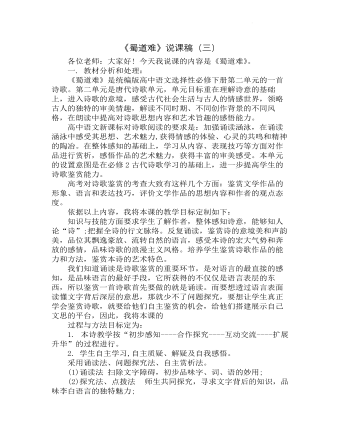
《蜀道难》说课稿(三) 2021-2022学年统编版高中语文选择性必修下册
(3)夸张到极致的技巧: (学生寻找出诗歌中的夸张语句,谈出感受) (4)多样的诗歌意境: 为了表达主观感受与目的的需要,诗歌中构织不同的意境:高峻、宏伟、神奇、凄清、恐怖等各种意境均有描绘,而这些意境又统统表现一个“难”字。 (5)神秘的传说: “五丁开山”“太阳神回车”“子规哀啼”等传说的出现,使全诗笼罩一种神秘气氛,也从另一个角度表现出了一个“难”字。 2、明确诗歌的主旨和情感。 这首诗以咏叹为基调,一叹蜀道之高,二叹蜀道之险,三叹蜀中战祸之烈,而战祸之烈是由于蜀道高险给割据者创造了良好条件的缘故。因此,对军事叛乱的警惕正是诗人的主旨所在。“蜀地不可去,不可居”是其表达的要义。(设计目的在于:1、全面把握诗歌的艺术特色,以便学生写作借鉴,掌握作文的技巧。2、把握诗歌主旨,更深刻理解诗人的情感)
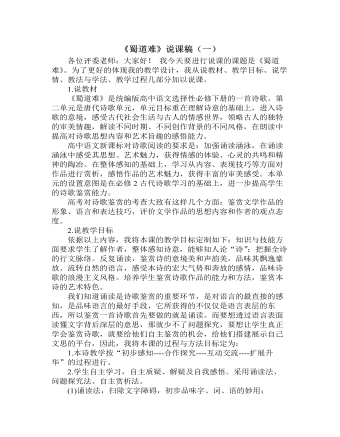
《蜀道难》说课稿(一) 2021-2022学年统编版高中语文选择性必修下册
(3)夸张到极致的技巧: (学生寻找出诗歌中的夸张语句,谈出感受)(4)多样的诗歌意境: 为了表达主观感受与目的的需要,诗歌中构织不同的意境:高峻、宏伟、神奇、凄清、恐怖等各种意境均有描绘,而这些意境又统统表现一个“难”字。(5)神秘的传说: “五丁开山”“太阳神回车”“子规哀啼”等传说的出现,使全诗笼罩一种神秘气氛,也从另一个角度表现出了一个“难”字。九.课后探讨本文主旨历来争议不定,明确诗歌的主旨和情感。 我首先指导方法, “知人论世” 是评论文学作品的一种原则 。知人,就是了解作者其人及作者与作品的关系。论世,就是要了解作者所处的时代、环境。接着打出李白在长安的介绍。说明李白踌躇满志而来,却受到权贵的忌恨,被放还乡。接着打出唐玄宗时期的介绍,说明太平景象背后潜伏的危机。然后让学生分组讨论,本课的写作意图是什么?
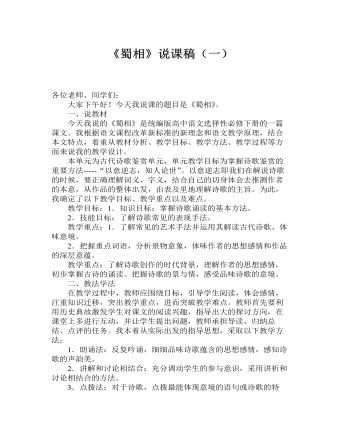
《蜀相》说课稿(一) 2021-2022学年统编版高中语文选择性必修下册
我将本节课分为三个部分:1.情境导入先运用多媒体,展示电影《赤壁》的几张图片,通过“赤壁之战”将三国时期这场经典战争诸葛亮的智谋呈现给学生,吸引学生走进历史,激发想象力和趣味性,提高学生的学习主动性。在成功吸引学生注意力过后,再向他们说,这只是历史中的一部分,在“赤壁之战”前后,诸葛亮一生的故事是怎样的呢?下面我们来看看唐代大诗人杜甫的《蜀相》,他是怎样用精辟的诗句概括的。2.讲授新课在成功吸引学生注意力后,迅速将他们带入课文讲授阶段。第一,进行作者介绍,其目的是为了使学生在整体上把握诗人的经历、写作技巧、艺术风格及写作背景。第二,多诵读,多推敲,理解诗中的言外之意。第三,把握重点词语,分析景物意象,体味作者的思想感情和作品的深层意蕴。感受诗人忧国忧民强烈的爱国主义感情。
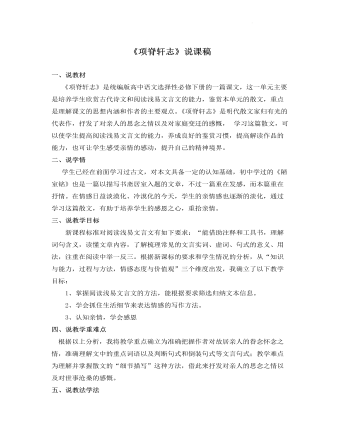
《项脊轩志》说课稿 2021-2022学年统编版高中语文选择性必修下册
1.诵读法。鉴赏文学作品应在反复诵读的基础上进行,在诵读的过程中,学生声情并茂,有利于体会作者所表达的情感。2.情景教学法。借助多媒体辅助教学,营造良好的学习氛围,激发学生的学习兴趣。3.点拨、讨论法。学生对老师设置的思考题以及自己不理解的地方进行讨论,得出比较准确的答案,老师在适当的时候给以点拨。学法:“新课标”旨在建立“自主—合作—探究”的学习方式,课堂上学生“学会学习”比“学会什么”更为重要,因此我设计如下学法:1、自主学习法:学生是学习的主体,让学生带着问题读书,目的明确,学生边读边思考问题,并简单分析散文的结构和作者所表达的情感。2、合作探究法:学生以小组合作的形式,选择一个自己感受最深的语段以及文中的重点词语去探讨作者是怎样表达他的悲痛之情的,然后交流各自的体会。
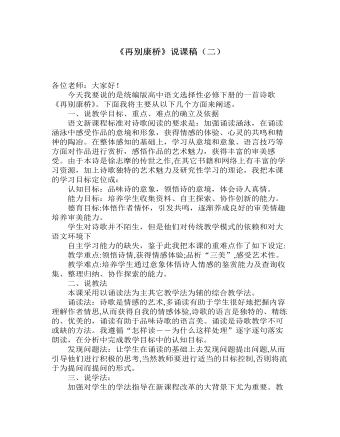
《再别康桥》说课稿(二) 2021-2022学年统编版高中语文选择性必修下册
康桥风光、剑桥大学风貌(配上剑桥的优美图片,让学生从视觉上对课文有一定的感知,帮助理解诗人的“康桥情结”)2.诵读体味(教学重点的解决)先让学生自由朗诵。要求学生谈谈对全诗的整体感受教师稍加点拨,答案不需标准,只要整体把握正确即可。然后逐字逐句指导朗诵并结合作者独特的人生际遇分析本诗所体现的诗情和艺术上的“三美”,从而达到准确把握作品主旨的目的。这种引导是循序渐进的,也符合学生的认知规律。简介诗歌“三美”追求闻一多先生是我国现代文学史上集诗人、学者和斗士于一身的重要诗人。他不但致力于新诗艺术美的探索,提出了音乐美(音节)、绘画美(词藻)、建筑美(节的匀称和句的均齐)的诗歌\"三美\"的新格律诗理论主张,还努力进行创作实践,写出了许多精美诗篇。他的新格律诗理论被后人称为现代诗学的奠基石,影响深远。
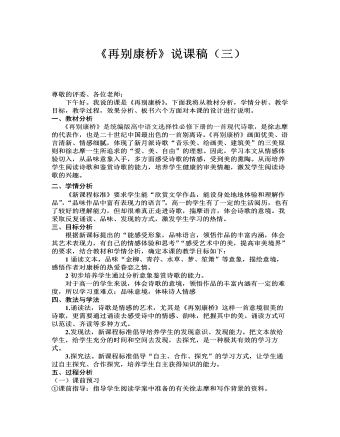
《再别康桥》说课稿(三) 2021-2022学年统编版高中语文选择性必修下册
四、教法与学法1.诵读法,诗歌是情感的艺术,尤其是《再别康桥》这样一首意境很美的诗歌,更需要通过诵读去感受诗中的情感、韵味,把握其中的美。诵读方式可以范读、齐读等多种方式。2.发现法,新课程标准倡导培养学生的发现意识、发现能力。把文本放给学生,给学生充分的时间和空间去发现,去探究,是一种极其有效的学习方式。3.探究法。新课程标准倡导“自主、合作、探究”的学习方式,让学生通过自主探究、合作探究,培养学生自主获得知识的能力。 五、过程分析(一)课前预习①课前指导:指导学生阅读学案中准备的有关徐志摩和写作背景的资料。②指导学生诵读文本,读准字音,读出节奏,体会感情。鉴赏诗歌离不开诗歌意象和有感情的诵读,引导学生边读边思考:诗歌写了什么内容?从哪些句子看出来?勾画出你感受最深的句子。怎样朗读才能从分表达作者的感情?让学生设计一个自己认为最值得探究的问题。让学生设计一个自己认为本文最值得探究的问题。
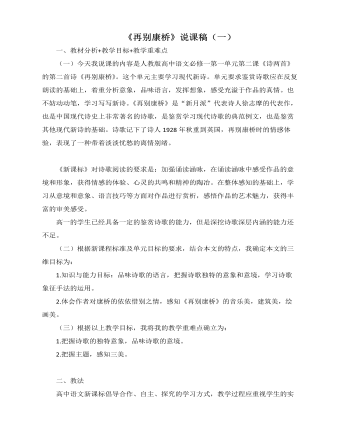
《再别康桥》说课稿(一) 2020-2021学年统编版高中语文选择性必修下册
2.对比联想法。让学生在诵读的基础上,对《再别康桥》中康桥美景的赏析和意象进行解读,引导学生欣赏诗歌的画面美,从而受到审美的体验。3.探究式学习法。引导学生对《再别康桥》情感和主题的探究。充分发挥学生自主学习的能力,引导学生主动地获取知识,重视学生的实践活动。三、学法1、诵读法 加强诵读,这是阅读诗词的一般方法。2、体悟法 通过意象把握情感,主要是让学生设身处地走进雨巷去感悟。3、联想比较法 通过与诗人的其他作品的比较学习,体会创作风格及作者情感。四、教学过程教学过程设计一、导入自古以来,离别总免不了沉重的愁绪。比如王维《宋元二使安西》:劝君更尽一杯酒,西出阳关无故人。李白《黄鹤楼送孟浩然之广陵》:孤帆远影碧空尽,唯见长江天际流。柳永《雨霖铃》执手相看泪眼,竟无语凝噎。正所谓自古多情伤离别,更那堪冷落清秋节啊。(设计目的:以离别主题的诗歌导入课文,让学生更快地进入课文情境。)

古诗词诵读《将进酒》说课稿2021-2022学年高中语文统编版选择性必修上册
一、说教材选修课是在必修课程基础上的拓展与提高,它力争促进学生各自特长和个性的形成。我们在必修部分已经学习了李白的一首古风《蜀道难》,学生对李白其人及其诗风已有了一定的了解。本单元的任务是“因声求气,吟咏诗韵”,它要求我们通过对古典诗歌声律特点的把握,学习有感情地吟咏,诵读作品,并深入地了解诗歌的感情。《将进酒》一诗时而奔放,时而深沉,感情大起大落变化明显,学生容易进入吟咏和体会情感的体验阅读中。二、说教法学法现代语文观念中提倡语文教学要多读,要培养学生的语感,特别是对一些优秀的古诗文。可见在学习古代诗文的过程中,诵读是非常重要的,有助于加深学生对课文思想内容的理解。可以在朗读中理解诗文的内容,所谓“读书百遍其义自见”,在反复的朗读中可以慢慢体会诗人所要表达的思想感情,因此本堂课我采取以诵读为线索,完成对诗歌思想内容的理性思考。
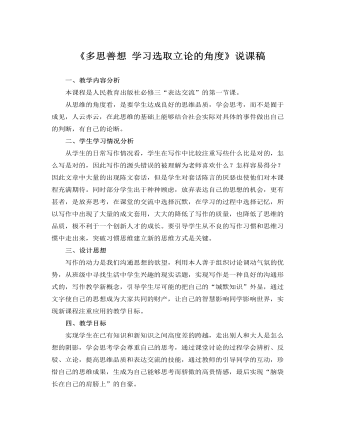
人教版高中语文必修3《多思善想 学习选取立论的角度》说课稿
谈到这,如果有人会说这仅仅是在于我个人与战场之上,战场之下另当别论,那么,他完全错了。在我小学四年级的语文课上有两个人发言积极,一个姓黄,一个姓康,黄同学发言比康同学更积极,班上的同学常以为黄同学是个了不得的人物,后来,教语文的吴老师曾悄悄地告诉我:班上真正厉害的是康x,那黄x没什么,说的全是“一点通”上的,照搬不误。说到这,我还得厚着脸皮自夸一下,在四年级时,我和康同学是同坐,一次,老师叫我们对一片课文(好象是写黄继光舍身炸暗堡)的一个段落提问题时,我悄悄地对康同学说了一个问题,康同学对我说:“你站起来说嘛。”内向的我遥遥头,康同学便站举手,并起来将我的问题大声地说了出来,结果老师说:“恩,康x的问题提得很好。”

新人教版高中英语选修2Unit 1 Science and Scientists-Discovering useful structures教学设计
The grammatical structure of this unit is predicative clause. Like object clause and subject clause, predicative clause is one of Nominal Clauses. The leading words of predicative clauses are that, what, how, what, where, as if, because, etc.The design of teaching activities aims to guide students to perceive the structural features of predicative clauses and think about their ideographic functions. Beyond that, students should be guided to use this grammar in the context apporpriately and flexibly.1. Enable the Ss to master the usage of the predicative clauses in this unit.2. Enable the Ss to use the predicative patterns flexibly.3. Train the Ss to apply some skills by doing the relevant exercises.1.Guide students to perceive the structural features of predicative clauses and think about their ideographic functions.2.Strengthen students' ability of using predicative clauses in context, but also cultivate their ability of text analysis and logical reasoning competence.Step1: Underline all the examples in the reading passage, where noun clauses are used as the predicative. Then state their meaning and functions.1) One theory was that bad air caused the disease.2) Another theory was that cholera was caused by an infection from germs in food or water.3) The truth was that the water from the Broad Street had been infected by waste.Sum up the rules of grammar:1. 以上黑体部分在句中作表语。2. 句1、2、3中的that在从句中不作成分,只起连接作用。 Step2: Review the basic components of predicative clauses1.Definition
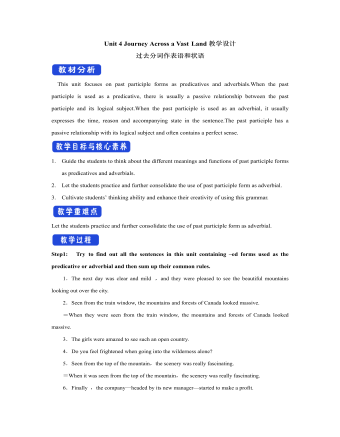
新人教版高中英语选修2Unit 4 Journey Across a Vast Land教学设计
当孩子们由父母陪同时,他们才被允许进入这个运动场。3.过去分词(短语)作状语时的几种特殊情况(1)过去分词(短语)在句中作时间、条件、原因、让步状语时,相当于对应的时间、条件、原因及让步状语从句。Seen from the top of the mountain (=When it is seen from the top of the mountain), the whole town looks more beautiful.从山顶上看,整个城市看起来更美了。Given ten more minutes (=If we are given ten more minutes), we will finish the work perfectly.如果多给十分钟,我们会完美地完成这项工作。Greatly touched by his words (=Because she was greatly touched by his words), she was full of tears.由于被他的话深深地感动,她满眼泪花。Warned of the storm (=Though they were warned of the storm), the farmers were still working on the farm.尽管被警告了风暴的到来,但农民们仍在农场干活。(2)过去分词(短语)在句中作伴随、方式等状语时,可改为句子的并列谓语或改为并列分句。The teacher came into the room, followed by two students (=and was followed by two students).后面跟着两个学生,老师走进了房间。He spent the whole afternoon, accompanied by his mom(=and was accompanied by his mom).他由母亲陪着度过了一整个下午。

新人教版高中英语选修2Unit 1 Science and Scientists-Learning about Language教学设计
Step 7: complete the discourse according to the grammar rules.Cholera used to be one of the most 1.__________ (fear) diseases in the world. In the early 19th century, _2_________ an outbreak of cholera hit Europe, millions of people died. But neither its cause, 3__________ its cure was understood. A British doctor, John Snow, wanted to solve the problem and he knew that cholera would not be controlled _4_________ its cause was found. In general, there were two contradictory theories 5 __________ explained how cholera spread. The first suggested that bad air caused the disease. The second was that cholera was caused by an _6_________(infect) from germs in food or water. John Snow thought that the second theory was correct but he needed proof. So when another outbreak of cholera hit London in 1854, he began to investigate. Later, with all the evidence he _7_________ (gather), John Snow was able to announce that the pump water carried cholera germs. Therefore, he had the handle of the pump _8_________ (remove) so that it couldn't be used. Through his intervention,the disease was stopped in its tracks. What is more, John Snow found that some companies sold water from the River Thames that __9__________________ (pollute) by raw waste. The people who drank this water were much more likely _10_________ (get) cholera than those who drank pure or boiled water. Through John Snow's efforts, the _11_________ (threaten) of cholera around the world saw a substantial increase. Keys: 1.feared 2.when 3. nor 4.unless 5.that/which 6.infection 7.had gathered 8.removed 9.was polluted 10.to get 11. threat

新人教版高中英语选修2Unit 1 Science and Scientists-Reading and thinking教学设计
Step 5: After learning the text, discuss with your peers about the following questions:1.John Snow believed Idea 2 was right. How did he finally prove it?2. Do you think John Snow would have solved this problem without the map?3. Cholera is a 19th century disease. What disease do you think is similar to cholera today?SARS and Covid-19 because they are both deadly and fatally infectious, have an unknown cause and need serious public health care to solve them urgently.keys:1. John Snow finally proved his idea because he found an outbreak that was clearly related to cholera, collected information and was able to tie cases outside the area to the polluted water.2. No. The map helped John Snow organize his ideas. He was able to identify those households that had had many deaths and check their water-drinking habits. He identified those houses that had had no deaths and surveyed their drinking habits. The evidence clearly pointed to the polluted water being the cause.3. SARS and Covid-19 because they are both deadly and fatally infectious, have an unknown cause and need serious public health care to solve them urgently.Step 6: Consolidate what you have learned by filling in the blanks:John Snow was a well-known _1___ in London in the _2__ century. He wanted to find the _3_____ of cholera in order to help people ___4_____ it. In 1854 when a cholera __5__ London, he began to gather information. He ___6__ on a map ___7___ all the dead people had lived and he found that many people who had ___8____ (drink) the dirty water from the __9____ died. So he decided that the polluted water ___10____ cholera. He suggested that the ___11__ of all water supplies should be _12______ and new methods of dealing with ____13___ water be found. Finally, “King Cholera” was __14_____.Keys: 1. doctor 2. 19th 3.cause 4.infected with 5.hit 6.marked 7.where 8.drunk 9.pump 10.carried 11.source 12.examined 13.polluted 14.defeatedHomework: Retell the text after class and preview its language points

新人教版高中英语选修2Unit 1 Science and Scientists-Using langauge教学设计
This happens because the dish soap molecules have a strong negative charge, and the milk molecules have a strong positive charge. Like magnets, these molecules are attracted to each other, and so they appear to move around on the plate, taking the food coloring with them, making it look like the colors are quickly moving to escape from the soap.Listening text:? Judy: Oh, I'm so sorry that you were ill and couldn't come with us on our field trip. How are you feeling now? Better?? Bill: Much better, thanks. But how was it?? Judy: Wonderful! I especially liked an area of the museum called Light Games.it was really cool. They had a hall of mirrors where I could see myself reflected thousands of times!? Bill: A hall of mirrors can be a lot of fun. What else did they have?? Judy: Well, they had an experiment where we looked at a blue screen for a while, and then suddenly we could see tiny bright lights moving around on it. You'll never guess what those bright lights were!? Bill: Come on, tell me!? Judy: They were our own blood cells. For some reason, our eyes play tricks on us when we look at a blue screen, and we can see our own blood cells moving around like little lights! But there was another thing I liked better. I stood in front of a white light, and it cast different shadows of me in every color of the rainbow!? Bill: Oh, I wish I had been there. Tell me more!? Judy: Well, they had another area for sound. They had a giant piano keyboard that you could use your feet to play. But then, instead of playing the sounds of a piano, it played the voices of classical singers! Then they had a giant dish, and when you spoke into it, it reflected the sound back and made it louder. You could use it to speak in a whisper to someone 17 meters away.? Bill: It all sounds so cool. I wish I could have gone with you? Judy: I know, but we can go together this weekend. I'd love to go there again!? Bill: That sounds like a great idea!

新人教版高中英语选修2Unit 2 Bridging Cultures-Discovering useful structures教学设计
The grammar of this unit is designed to review noun clauses. Sentences that use nouns in a sentence are called noun clauses. Nominal clauses can act as subject, object, predicate, appositive and other components in compound sentences. According to the above-mentioned different grammatical functions, nominal clauses are divided into subject clause, object clause, predicate clause and appositive clause. In this unit, we will review the three kinds of nominal clauses. Appositive clauses are not required to be mastered in the optional compulsory stage, so they are not involved.1. Guide the students to judge the compound sentences and determine the composition of the clauses in the sentence.2. Instruct students to try to learn grammar by generalizing grammar rules, controlling written practice, and semi-open oral output.3. Inspire the students to systematize the function and usage of noun clause1.Instruct students to try to learn grammar by generalizing grammar rules, controlling written practice, and semi-open oral output.2.Inspire the students to systematize the function and usage of noun clauseStep1: The teacher ask studetns to find out more nominal clauses from the reading passage and udnerline the nominal clauses.

新人教版高中英语选修2Unit 3 Food and Culture-Discovering useful structures教学设计
The newspaper reported more than 100 people had been killed in the thunderstorm.报纸报道说有一百多人在暴风雨中丧生。(2)before、when、by the time、until、after、once等引导的时间状语从句的谓语是一般过去时,以及by、before后面接过去的时间时,主句动作发生在从句的动作或过去的时间之前且表示被动时,要用过去完成时的被动语态。By the time my brother was 10, he had been sent to Italy.我弟弟10岁前就已经被送到意大利了。Tons of rice had been produced by the end of last month. 到上月底已生产了好几吨大米。(3) It was the first/second/last ... time that ...句中that引导的定语从句中,主语与谓语构成被动关系时,要用过去完成时的被动语态。It was the first time that I had seen the night fact to face in one and a half years. 这是我一年半以来第一次亲眼目睹夜晚的景色。(4)在虚拟语气中,条件句表示与过去事实相反,且主语与谓语构成被动关系时,要用过去完成时的被动语态。If I had been instructed by him earlier, I would have finished the task.如果我早一点得到他的指示,我早就完成这项任务了。If I had hurried, I wouldn't have missed the train.如果我快点的话,我就不会误了火车。If you had been at the party, you would have met him. 如果你去了晚会,你就会见到他的。
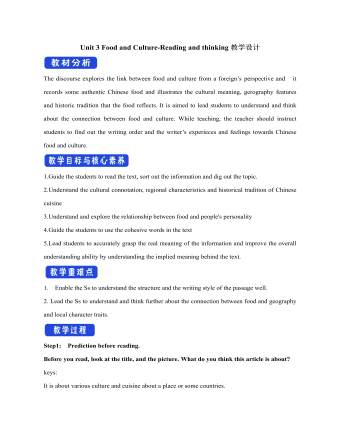
新人教版高中英语选修2Unit 3 Food and Culture-Reading and thinking教学设计
The discourse explores the link between food and culture from a foreign’s perspective and it records some authentic Chinese food and illustrates the cultural meaning, gerography features and historic tradition that the food reflects. It is aimed to lead students to understand and think about the connection between food and culture. While teaching, the teacher should instruct students to find out the writing order and the writer’s experieces and feelings towards Chinese food and culture.1.Guide the students to read the text, sort out the information and dig out the topic.2.Understand the cultural connotation, regional characteristics and historical tradition of Chinese cuisine3.Understand and explore the relationship between food and people's personality4.Guide the students to use the cohesive words in the text5.Lead students to accurately grasp the real meaning of the information and improve the overall understanding ability by understanding the implied meaning behind the text.1. Enable the Ss to understand the structure and the writing style of the passage well.2. Lead the Ss to understand and think further about the connection between food and geography and local character traits.Step1: Prediction before reading. Before you read, look at the title, and the picture. What do you think this article is about?keys:It is about various culture and cuisine about a place or some countries.

